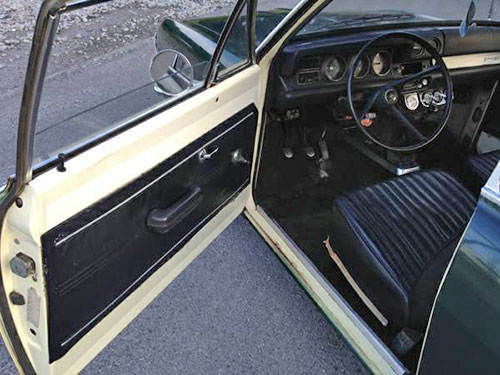A Local Find: 1968 Opel Kadett

Some long-time Spannerhead readers may be aware of my affection for the 1970-1975 Opel Manta. I featured an example of the spry little coupe in my first Ones That Got Away series post, and mused on it again more recently. I’d love to own one, and seeing as how one of my default downtime Internet activities is Craigslist tire-kicking, I type the term “Opel” quite often in the Craiglist search field.
But Mantas are rare beasts in the US, and what pops up most frequently are GTs, Opel’s more popular, plastic-bodied mini-Corvette. Last week, though, an ad for the 1968 Kadett shown in this post appeared.

Built from 1965 to 1973, the Kadett B, as it’s called, is mechanically similar to the Manta, but doesn’t quite match its stablemate’s delicate proportions and detailing. The Kadett is much more prosaic-looking, but it still has a great deal of charm. This particular car has been repainted, as evidenced by the color of the engine bay and door frames, among other bits, but at least the deep green is a lovely, classic choice of hue.

The interior needs some help. The dash is cracked in multiple places, but the seats appear to be in good shape. It’s possible the owner added the aftermarket gauges because the originals were too difficult to repair or too rare to find working replacements for.

Some rust is in evidence on the door sill, probably a sign of additional rot elsewhere.

As with the fronts, the back seats seem to be in very good shape.

As far as I can determine, the engine fitted to this Kadett is a 4-cylinder, 1.5l, 64-hp CIH unit. It’s certainly not going to win any races, but the appeal of the car isn’t the performance, but the style and the experience. It’s a fair bet the carb isn’t original, but overall, the engine bay is remarkably clean. A little elbow grease and it would be very presentable indeed.

The seller also includes OEM literature, always a bonus. I wonder if the car was painted to match the covers?
I’ve tried to figure out what it is exactly that draws me to these little vintage coupes, and I’ve decided it’s what I’m going to call the European Mustang Effect. As Ate Up With Motor discusses in its excellent history of the contemporary Ford Capri, small coupes like the Kadett, Manta and contemporary Capri filled the niche in Europe the Mustang did in the US: Plucky, stylish personal statements that were thoroughly customizable to each buyer’s specific preferences. They had a dash of performance (the Capri and Manta more so than the Kadett coupe), but like the Mustang, above all, their most prominent attribute was that they were—and are—incredibly cool. Other cars were faster, and cheaper and handled better, but none cornered the market on cool quite as effectively as the Mustang in America, or the Capri and Manta in Europe.
Having spent 5 of my formative years in France, and that period being the real genesis of my automotive interest, it’s understandable my initial tastes would have been shaped by what was around me at that time. So as much as car buffs who grow up in the States have an ingrained affection for the apple-pie-American Mustang and its domestic flavor of cool, I think I was weaned on the European variation of that quality. As a result, I’ve always had a semi-conscious affection for sporty RWD coupes from that side of the pond. That’s the formula that holds the greatest appeal for me.






